Berkheya angustifolia
Berkheya angustifolia (Houtt.) Merr.
Family: Asteraceae
Common names: narrow-leaved berkheya, needle-leaved Cape thistle (Eng.)
Introduction
Berkheya angustifolia is a spiny, thistle-like plant with striking, bright yellow blooms. It is resilient in arid landscapes, a plant that thrives where others stutter. It offers a captivating glimpse into the beauty and variety of the South African flora.
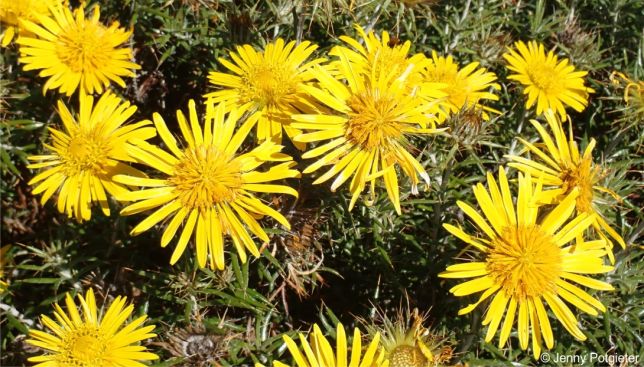
Description
Description
Berkheya angustifolia is a perennial shrublet with multiple stems from a woody rootstock. This plant usually grows in a sprawling, rounded shape, spreading up to 450 mm. In summer it produces flowering stems that can reach up to 600 mm, each tipped with a solitary flower head, creating a dramatic show of the flower colour above the foliage. It has dusty silver-green, leathery leaves, white-felted underneath, with a narrow and pointy shape, the edges are rolled under, slightly toothed and spiny. The upper side of the leaf becomes darker green and hairless when mature.
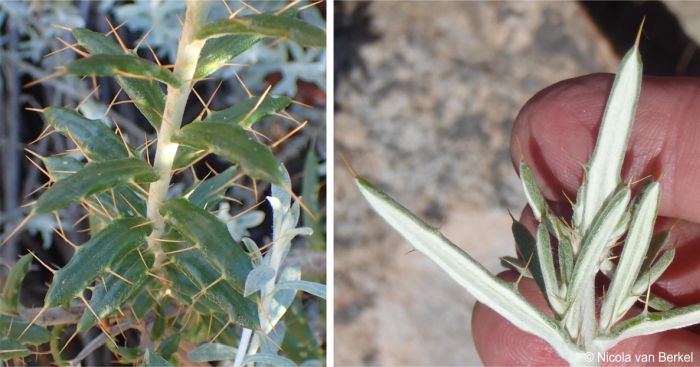
The biggest highlight of this plant is its flower heads, they are classic daisies, with vibrant yellow ray petals spreading from the darker yellow, central disk. Each flower head usually has a diameter of 80-100 mm. It flowers mainly in spring and early summer (August to November), and a plant can have multiple flowers open at one time. After the flowers have withered, the plant produces seeds in the center of the flower head, these are small hard seeds that will fall out when they are ripe and ready to form new plants.
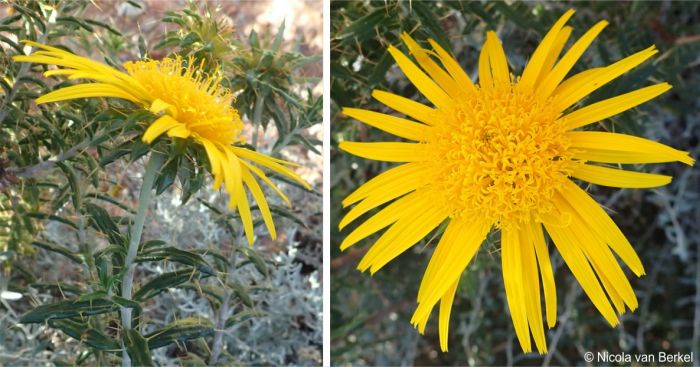
Conservation Status
Status
Berkheya angustifolia is currently assessed as Least Concern (LC) by the Red List of South African Plants. This indicates that the plant is widespread, common and not threatened by extinction.
Distribution and habitat
Distribution description
This species is a South African endemic, native to the warmer regions of the Eastern Cape and Western Cape provinces. This species is not considered threatened or rare, it grows on rocky hillsides in various habitats from grasslands to fynbos and thicket, from the Swartberg to Makhanda. It has the ability to grow in poor, well-drained soil, often where other plant struggle. The plant is adapted to survive with minimum rainfall, showing excellent drought tolerance. Importantly it is a suitable garden choice for water-wise gardening.
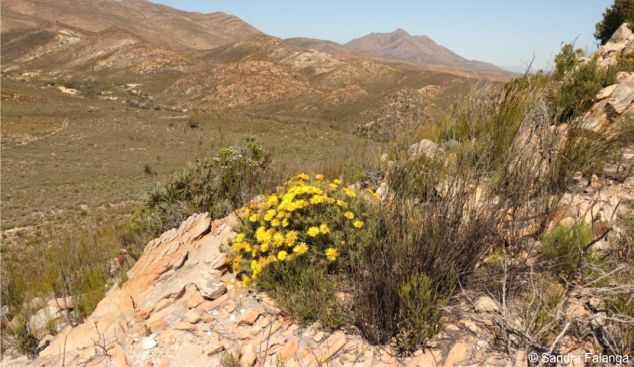
Derivation of name and historical aspects
History
The scientific name of this plant holds clues to its identity. The genus name honours Johannes Le Francq Van Berkhey, a Dutch botanist and physician in the 18th century. The species name angustifolia is derived from Latin, it combines two words, which are angustus meaning ‘narrow’ and folium meaning ‘leaf’, a direct description of the plant’s distinctive foliage.
This species belongs to the very large and economically important daisy family, Asteraceae. It is one of the largest families of flowering plants in the world, containing over 32 000 species including well known garden plants like sunflower, daisies and chrysanthemums as well as edible lettuce and artichokes.
The genus Berkheya is found primarily in southern Africa. It is a large genus with about 75 species which share the same characteristics of spiny, thistle-like leaves. The genus includes other notable members such as Berkheya purpurea, which is cultivated for its striking purple flowers, and Berkheya radula, a species with large spiny leaves.
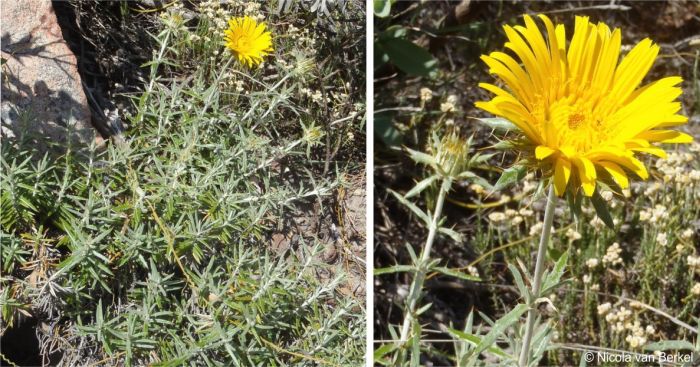
Ecology
Ecology
Berkheya angustifolia has evolved a number of strategies that help it to grow and survive in its challenging environment. The woody rootstock is the main key adaptation that acts as a storage organ for water and nutrients, allowing the plant to survive long periods of drought.
Like many plants of the daisy family, it relies on insects for pollination, its vibrant yellow flowers attract a wide range of pollinators including bees, butterflies and beetles. The open disk-like shape of the flower makes it easily accessible, allowing insects to feed on its nectar and pollen.
The seeds are small and hard, after flowering the seeds mature with the dried-out flower head. When the seeds are matured, they will fall to the ground through gravity dispersal near the parent plant, ensuring that the new plant will grow in a location that has already been proven to be suitable for survival.
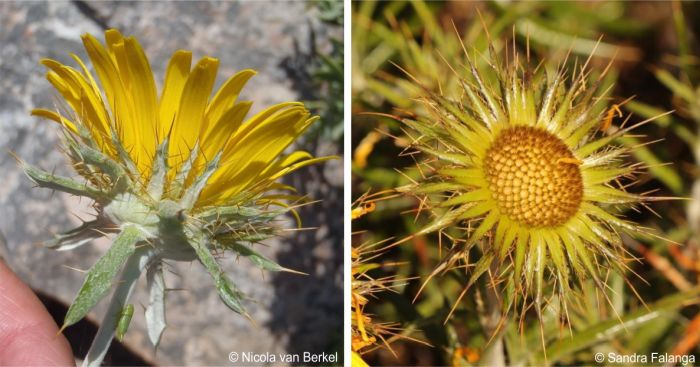
Uses
Use
There is no published information on the traditional medicinal uses of Berkheya angustifolia, however other members of the same genus, like Berkheya setifera and B. heterophylla, are used to treat various illnesses such as stomach complaints, inflammation, chest pain and colic.
The plant is not known to be edible nor does it have any craft uses.
It is a rewarding garden plant, particularly for its hardiness and striking appearance, and can be used in variety of horticulture practices such as a cut flower, in public spaces due to its low maintenance, in rock gardens, as a pot plant and in water-wise gardens. It is sold in nurseries that focuses on indigenous or drought-tolerant plants. Its resilience and low maintenance make it a better choice for water conservation and sustainable gardening.
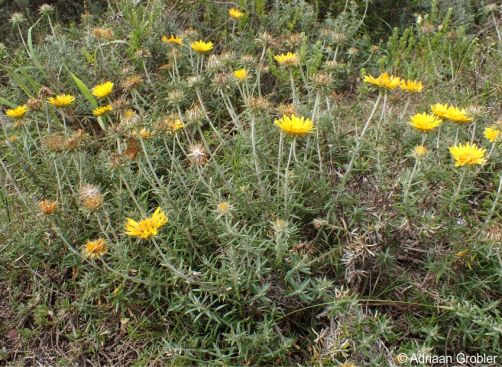
Growing Berkheya angustifolia
Grow
Berkheya angustifolia is easily propagated from seeds, which show a high germination percentage. Sow the seeds in autumn (March to May) as this mimics their natural germination period. Use a well-drained mixture of sand and potting soil with a ratio of 2:1. Use a flat seed tray to allow sufficient germination space. Gently spread the seeds on the growing medium and lightly cover with a thin layer of sand, keep the tray in a warm bright spot but not directly in sunlight.
The medium should be kept moist at all times. Once the seedling have their first set of true leaves you need to prick them out and pot them up into plastic bags or pots. The young plants should be kept in a sheltered place and watered regularly. The species usually flower in their second year after germination.
Berkheya angustifolia must be cultivated in full sun to ensure it produces the maximum number of flowers. It is highly adaptable and will grow in wide range of soils, from sandy to loamy, given that it has excellent drainage. As a drought tolerant plant it needs little to no water once planted. It does not require fertilizer, and over feeding can lead to soft growth that is open to disease and pests. A layer of mulch around the base can help with suppressing the weeds. Prune away old inflorescences after flowering to encourage new growth from the base.
This plant is a good choice for rockeries, scree gardens, and gravel gardens. It is also suitable for containers, as long as the pot has excellent drainage. For companion plants, choose species with similar requirements, i.e. full sun and dry conditions. This can include other species of Berkheya, Agapanthus, Euryops and salvias, which have the potential to create an even and sustainable planting scheme.
Berkheya angustifolia is remarkably tough and pest resistant, and is generally not troubled by most garden pests. Its spiny leaves protect it from insects and herbivores. The species is prone to root rot which happens as a result of insufficient drainage. Conditions where it is always wet, can cause fungal diseases like powdery mildew. This can be prevented by ensuring good air circulation in the soil.
References
- Bredenkamp, C. 2019. A flora of the Eastern Cape Province. Strelitzia 41. Volume 1. South African National Biodiversity Institute, Pretoria.
- Falanga, S. 2021-Oct. Observation of Berkheya angustifolia, Zebraskop, WC. iNaturalist. Online. https://www.inaturalist.org/observations/98263110.
- Grobler, A. 2022-Oct. Observation of Berkheya angustifolia, Gqeberha, EC. iNaturalist. Online. https://www.inaturalist.org/observations/141518381.
- Manning, J. & Goldblatt, P. 2012. Plants of the Greater Cape Floristic Region 1: the Core Cape Flora. Strelitzia 29. South African National Biodiversity Institute, Pretoria.
- Manning, J. 2007. Field guide to Fynbos. Struik Publishers, Cape Town.
- Ndlovu, B. 2020. Berkheya setifera DC. (Asteraceae). PlantZAfrica. Online. https://pza.sanbi.org/berkheya-setifera.
- Powrie, F. (ed) 1998. Grow South African Plants. A gardener's companion to indigenous plants. National Botanical Institute, Cape Town.
- Potgieter, J. 2021-Oct. Observation of Berkheya angustifolia, Zebraskop, WC. iNaturalist. Online. https://www.inaturalist.org/observations/97764055.
- Raimondo, D., Von Staden, L., Foden, W., Victor, J.E., Helme, N.A., Turner, R.C., Kamundi, D.A. & Manyama, P.A. (eds) 2009. Red list of South African plants. Strelitzia 25. South African National Biodiversity Institute, Pretoria.
- Slabber, S.& Steyn, H. 2015. Crabbea angustifolia Nees. (Acanthaceae). PlantZAfrica. Online. https://pza.sanbi.org/crabbea-angustifolia.
- Smith, G. 1966. A history of botanical art in South Africa. Purnell & Sons, Cape Town.
- Van Berkel, N. 2015-Oct. Observation of Berkheya angustifolia, Paardekop Farm, WC. iNaturalist. Online. https://www.inaturalist.org/observations/11151111.
- Van Berkel, N. 2021-Jun. Observation of Berkheya angustifolia, Rooiberg Pass, WC. iNaturalist. Online. https://www.inaturalist.org/observations/83846078.
- Van Wyk, B.-E. & Gericke, N. 2000. People's plants, a guide to useful plants of southern Africa. Briza Publications, Pretoria.
- Vlok, J. & Schutte-Vlok, A.L. 2010. Plants of the Klein Karoo. Umdaus Press, Hatfield.
Credits
Mashudu Tshitereke and Ondisaho Ramabulana
Walter Sisulu National Botanical Garden
September 2025
Acknowledgements: images by Adriaan Grobler, Jenny Potgieter, Nicola van Berkel and Sandra Falanga, from their observations shared on iNaturalist.
Plant Attributes:
Plant Type: Shrub
SA Distribution: Eastern Cape, Western Cape
Soil type: Sandy, Loam
Flowering season: Spring, Winter
PH: Acid, Neutral
Flower colour: Yellow
Aspect: Full Sun
Gardening skill: Average
Special Features:
Horticultural zones
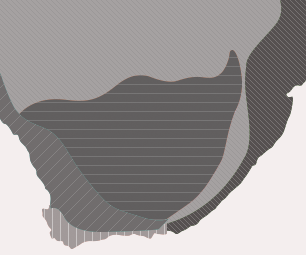







Rate this article
Article well written and informative
Rate this plant
Is this an interesting plant?
Login to add your Comment
Back to topNot registered yet? Click here to register.